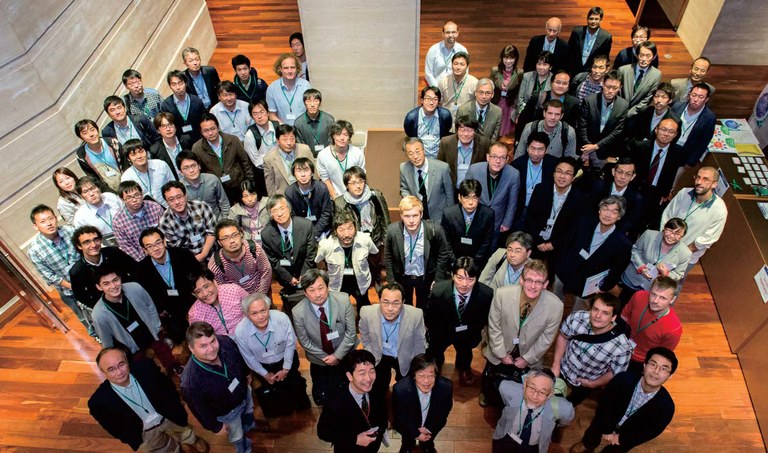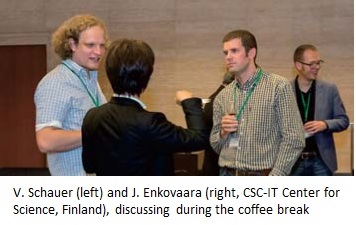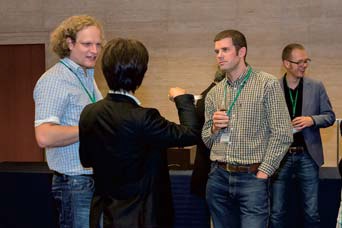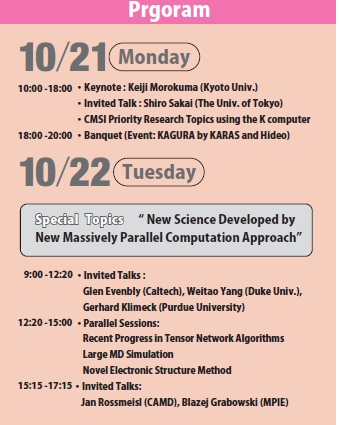Special Feature 1:International 2013 Symposium

Achievements of one year of shared use of the K Computer
The Symposium was held along with the following three satellite workshops :
1)CMSI Tokyo Satellite Workshop 2013 :Novel Electronic Structure Calculation Method
2)CMSI Nagoya Satellite Workshop 2013 :Large-Scale Molecular Simulation for Understanding Molecular Mechanisms
3)CMSI Kobe Satellite Workshop 2013 :Recent Progress in Tensor Network Algorithms Workshops 1) and 2) featured researchers from Japan and other countries who spoke about the achievements of, respectively,RSDFT, a real-space first principles density functional theory (DFT) calculation software program that opened up the development of massively parallel computing in computational materials science through the use  of the K computer, and MODYLAS, a software program for conducting molecular dynamics simulations for large-scale molecular systems, and the workshops were held to discuss the future prospects for these programs. Workshop 3) differed from the other two in that it dealt with the field of computational materials science overall and focused on efforts to promote integration with the field of mathematical science and the establishment of the fundamental building blocks for creating new algorithms. For more information on the individual workshops, see the separate report for each workshop. The first day of the conference began with a keynote address from Professor Keiji Morokuma (Kyoto University). This was followed by presentations on research achievements by CMSI research group representatives. The second day featured three parallel sessions that were designed to share and go deeper into the issues and achievements raised in the satellite workshops and the presentations by 11 invited speakers from overseas.Through a happy accident of good timing,the symposium was held just after the announcement that the Nobel Prize in Chemistry 2013 had been awarded jointly to Martin Karplus, Michael Levitt and Arieh Warshel "for the development of multiscale models for complex chemical systems”―in other words, for the development of the so-called QM/MM hybrid method. At the beginning of his keynote address, Professor Morokuma spoke about the award-winning research and shared some anecdotes relating to Professor Karplus. Subsequently, he talked about a recent research achievement of his own group, the identification of numerous new reaction mechanisms following an exhaustive search of transition states,and discussed the power that supercomputers have given to computational materials science. It was a very impressive presentation. The invited speakers who talked about research issues in the individual sessions gave presentations on the impressive achievements in state-of-the-art research, and these were followed by lively debates and exchanges
of the K computer, and MODYLAS, a software program for conducting molecular dynamics simulations for large-scale molecular systems, and the workshops were held to discuss the future prospects for these programs. Workshop 3) differed from the other two in that it dealt with the field of computational materials science overall and focused on efforts to promote integration with the field of mathematical science and the establishment of the fundamental building blocks for creating new algorithms. For more information on the individual workshops, see the separate report for each workshop. The first day of the conference began with a keynote address from Professor Keiji Morokuma (Kyoto University). This was followed by presentations on research achievements by CMSI research group representatives. The second day featured three parallel sessions that were designed to share and go deeper into the issues and achievements raised in the satellite workshops and the presentations by 11 invited speakers from overseas.Through a happy accident of good timing,the symposium was held just after the announcement that the Nobel Prize in Chemistry 2013 had been awarded jointly to Martin Karplus, Michael Levitt and Arieh Warshel "for the development of multiscale models for complex chemical systems”―in other words, for the development of the so-called QM/MM hybrid method. At the beginning of his keynote address, Professor Morokuma spoke about the award-winning research and shared some anecdotes relating to Professor Karplus. Subsequently, he talked about a recent research achievement of his own group, the identification of numerous new reaction mechanisms following an exhaustive search of transition states,and discussed the power that supercomputers have given to computational materials science. It was a very impressive presentation. The invited speakers who talked about research issues in the individual sessions gave presentations on the impressive achievements in state-of-the-art research, and these were followed by lively debates and exchanges
of information.
How will software development change?
One of the important research topics in computational materials science is the development of new calculation theories and calculation models that can expand
the scope of applicable targets and phenomena.The QM/MM hybrid method was first proposed in the 1970s, but (it is my impression that) it was not until the mid-1990s that it rapidly came into wide-spread use. This is because of the contributions of many researchers that resulted in improved calculation methods and software, as well as because of increased computer performance. In addition, the development of the field of life science meant that, for the purpose of identifying the functions of biomolecules, there was an increased demand for “observation” simulations of the structure and dynamics of molecules inside living organisms(in aqueous solutions) that are difficult to observe through experimentation.As shown by this and other examples, a number of conditions must be met in order for a calculation  model to be recognized as useful and to come into widespread use. But in many cases if one waits to begin research until these conditions are met, it will be too late. The revolutionary computation performance achieved by the K computer is expected to serve as the catalyst for producing next-generation calculation models and software, but continuous efforts based on a long-term perspective and an organization to support these efforts will be indispensable in order to make this a reality.
model to be recognized as useful and to come into widespread use. But in many cases if one waits to begin research until these conditions are met, it will be too late. The revolutionary computation performance achieved by the K computer is expected to serve as the catalyst for producing next-generation calculation models and software, but continuous efforts based on a long-term perspective and an organization to support these efforts will be indispensable in order to make this a reality.
One of the missions of CMSI is to disseminate and promote the software that is developed in projects. To this end, CMSI puts a great deal of effort into promoting activities such as the use of the MateriApps portal site, the holding of software workshops, software distribution and soon. In this context, the presentation on nanoHUB by Professor Gerhard Klimeck(Purdue University) was impressive. nanoHUB was developed between 2002 and 2010 as a project of the U. S. National Science Foundation (NSF). It is a system designed to enable the sharing in cyberspace of simulation software, presentation tools, teaching tools and so on in the fields of nano science and nanotechnology,  and it is already in use worldwide. As an evolution of this type of system, I imagined
and it is already in use worldwide. As an evolution of this type of system, I imagined
(although possibly I am getting too far ahead of myself here)that we are approaching the point at which a system will be developed wherein, after it has been decided what should be calculated,the input data will be (semi-)automatically generated and then numerous / large-scale calculations will be executed through cloud computing, and subsequently the vast quantity of calculation results will be (semi-)automatically output in the form of academic papers and reports. (If this day comes, academic papers that are based on calculations alone may come to have no meaning.) Even if such a time comes, the development of new calculation models and calculation programs for these models will still be needed, and this will continue to be an important task. Apart from theoretical work, however, the development of calculation models and programs may be conducted by software companies, or if the market is not largeenough, this may be done by volunteer groups of specialists in the fields of information science, mathematical science and computational materials science and the results released as freeware.
(Kazuo Kitaura:Graduate School of System Informatics, Kobe University)

